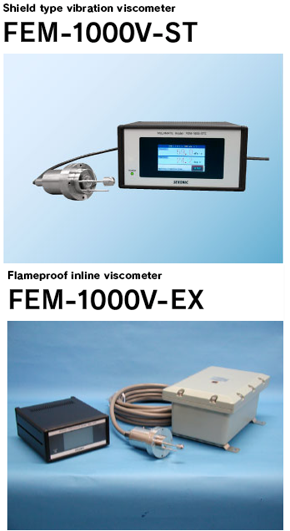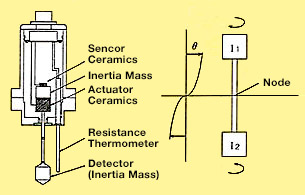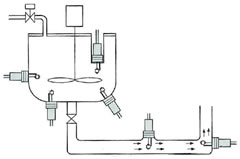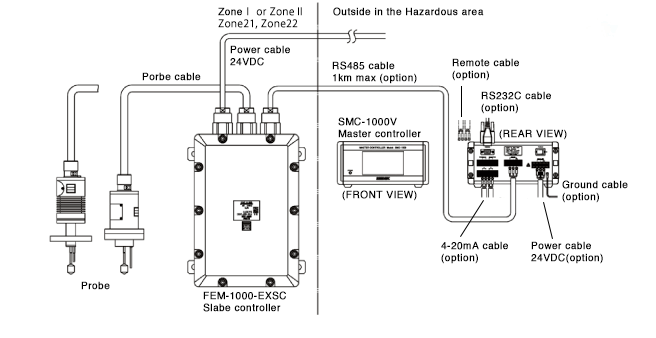FEM-1000V Series

In-line viscometer(For High precision)
FEM-1000V Series
These viscometers detect the viscosity of liquids through changes in vibrations.
A high resolution is achieved using a piezoelectric acceleration sensor.
These revolutionary products are based on the phenomenon of resonance.
Our unique balanced oscillator provides stable viscosity measurement and long-term reliability.
*Patented (Japan, US, UK)
● The FEM-1000V series are torsional vibration viscometers for use in in-line processes.
The viscometer can be attached to a tank or pipe with a flange to measure viscosity and temperature continuously and in real time.
● A piezoelectric ceramic is used in the actuator, so the viscometer does not require maintenance.
● The viscosity sensor (probe) is completely enclosed. In addition to its ability to be attached to a flange, the entire probe of non-flameproof models can be immersed in a liquid.
● The probe can be attached to a tank that is being stirred or a pipe with flowing liquid to measure viscosity while the liquid is flowing.
● The flameproof models are certified as such and can be used in controlled areas with peace of mind.
* *Please contact us for foreign specifications.
● Viscosity measurement accuracy is within ±1% of the measured value.
Regardless of whether the viscosity is 1 mPas or 800 mPas, the measurement accuracy is still within ±1% of the measured value.
● The probe is compact, robust, waterproof, and dustproof. It is made of corrosion-resistant stainless steel.
In addition, all wetted parts are welded, so the probe is highly airtight and easy to clean.
● These viscometers have a patented bidirectional balanced oscillator, which enables highly accurate viscosity measurement (±1% of measured value) that is not affected by process vibrations.
The probe can be installed in any direction, whether it be up, down, left, right, or at an angle to the direction of the liquid flow, enabling highly accurate measurement.
In addition, adjustments for mechanical stress/strain do not need to be made during installation.
● Highly accurate viscosity data, i.e., ±1% of the measured value, can be output externally as a 4-20 mA analog output or an RS232C digital output. Therefore, these viscometers are ideal for production control in automated production lines.
● These viscometers meet the following flameproofing standards:
- Probe
- FVM80A-PEXG
- Flameproof enclosure
- ExdⅡCT6
- Approval no. for the tested model
- TC18354
- Slave controller
- FEM-1000-EXSC
- Flameproof enclosure
- ExdⅡBT6
- Approval no. for the tested model
- TC18851
- Probe
- FVM80A-PEMT
- Flameproof enclosure
- ExdⅡCT3
- Approval no. for the tested model
- TC18356
- Slave controller
- FEM-1000-EXSC
- Flameproof enclosure
- ExdⅡBT6
- Approval no. for the tested model
- TC18851
● Probes made of different materials can be selected according to liquid conditions such as acid resistance, alkali resistance, oil resistance, and adhesion prevention.
● The controller has a phase-locked loop (PLL) circuit, and the oscillation frequency is constantly controlled so that it is the same as the resonance frequency of the oscillator.
As a result, these viscometers accurately measure viscosity even when the resonance frequency of the oscillator fluctuates due to factors such as temperature.
Uses
● Controlling polymerization or dispersion
● Controlling ink, paint, coating, and film formation
● Slurry, food, etc.
Structure and Principle

● A piezoelectric ceramic is used in the actuator for the viscosity detector.
● Two identical inertial masses (I1 (the actuator) and I2 (the detector)) located at the two ends of the torsion rod of the oscillator are vibrated in the direction of rotation.
The amplitude of vibrations is measured by each acceleration sensor attached to the upper inertial mass, and the viscous resistance determined by the viscosity detector is converted to viscosity.
● The (patented) resonance node in the center of the torsion rod serves as a fixed point, and the upper and lower inertia masses (I1 and I2) vibrate in opposite directions (a bidirectional balanced oscillator).
The node allows the probe to be installed anywhere, and adjustments for mechanical stress/strain do not need to be made during installation.
● The torsion rod is welded to the bottom of the probe housing via a torsion pipe and is completely enclosed.
Examples of probe installation in the FEM-1000V series

The balanced oscillator is actuated by the piezoelectric ceramic and can be installed in any direction.
*The figure on the left shows examples of probe installation and does not mean that multiple probes are required.
Composition of explosion proof


Teflon-coated probes (PTFE, PFA, FEP, etc.)
Effective for slurry liquids that are prone to scaling as well as liquids that are highly acidic or highly alkaline.

2S probe with a ferrule
Ferrules of various sizes are available.

Sanitary T-fitting
This is one way to install a viscometer in the piping of a food line.

Guard
A guard is placed around the detector to protect it from scratching, bending, etc. caused by hard solid matter in a liquid. The guard has no effect on viscosity measurement.
